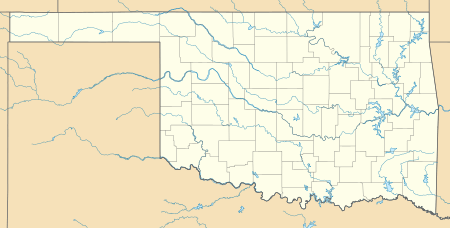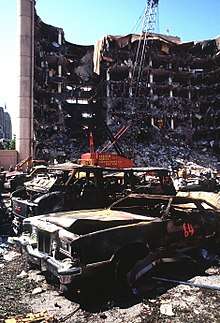Alfred P. Murrah Federal Building
The Alfred P. Murrah Federal Building was a United States federal government complex located at 200 N.W. 5th Street in Downtown Oklahoma City, Oklahoma, United States. On April 19, 1995, at 9:02 am the building was the target of the Oklahoma City bombing, which killed 168 people, including 19 children in a daycare.[1] Half of the building collapsed seconds after the truck bomb detonated. The remains were imploded a month after the attack, and the Oklahoma City National Memorial was built on the site.
| Alfred P. Murrah Federal Building | |
|---|---|
 The Alfred P. Murrah Federal Building in 1977 | |
 Location of the Alfred P. Murrah Federal Building in Oklahoma | |
| Alternative names | Alfred P. Murrah Building |
| General information | |
| Status | Demolished |
| Address | 200 Northwest 5th Street |
| Town or city | Oklahoma City, Oklahoma |
| Country | United States of America |
| Coordinates | 35°28′22″N 97°31′01″W |
| Opened | March 2, 1977 |
| Demolished | May 23, 1995 (damaged on April 19, 1995) |
| Owner | United States federal government |
Construction and use
The building was designed by architects Stephen H. Horton and Wendell Locke of Locke, Wright and Associates and constructed by J.W. Bateson using reinforced concrete in 1977[2] at a cost of $14.5 million. The building, named for federal judge Alfred P. Murrah, an Oklahoma native, opened on March 2, 1977.[3]
By the 1990s, the building contained regional offices for the Social Security Administration, the U.S. Department of Housing and Urban Development, the United States Secret Service, the Department of Veterans Affairs vocational rehabilitation counseling center, the Drug Enforcement Administration (D.E.A.), and the Bureau of Alcohol, Tobacco, and Firearms (ATF). It also contained recruiting offices for the US Military. It housed approximately 550 employees.[4] It also housed America's Kids, a children's day care center.
Prior bombing plots
In October 1983, members of the white supremacist group The Covenant, The Sword, and the Arm of the Lord (CSA), including founder James Ellison and Richard Snell plotted to park "a van or trailer in front of the Federal Building and blow it up with rockets detonated by a timer."[5] While the CSA was building a rocket launcher to attack the building, the ordnance accidentally detonated in one of the member's hands. The CSA took this as divine intervention and called off the planned attack. Convicted of murder in an unrelated case, Richard Snell was executed on April 19, 1995, the same day the bombing of the federal building was carried out, after Associate Supreme Court Justice Clarence Thomas declined to hear further appeal.[6]
Destruction
At 9:02 a.m. local time on April 19, 1995, a Ryder rental truck, containing approximately 7,000 pounds (3175 kg) of ammonium nitrate fertilizer, nitromethane, and diesel fuel was detonated in front of the building, destroying a third of it and causing severe damage to several other buildings located nearby. As a result, 168 people were killed, including 19 children, and over 800 others were injured.[7] It remains the deadliest domestic terrorist attack, with the most property damage, on American soil.
Timothy McVeigh, a US Army veteran, was found guilty of the attack in a jury trial and sentenced to death. He was executed in 2001. A co-conspirator, Terry Nichols, is serving multiple life sentences in a federal prison. Third and fourth subjects, Michael Fortier and his wife, Lori, assisted in the plot. They testified against both McVeigh and Nichols in exchange for a 12-year prison term for Michael and immunity for Lori. Michael was released into the witness protection program in January 2006.[8]
McVeigh said that he bombed the building on the second anniversary of the Waco siege in 1993 to retaliate for U.S. government actions there and at the siege at Ruby Ridge. Before his execution, he said that he did not know a day care center was in the building and that, had he known, "It might have given me pause to switch targets."[1] The FBI said that he scouted the interior of the building in December 1994 and likely knew of the day care center before the bombing.[9]
Artwork in the building
Many works of art were in the building when it was destroyed in the Oklahoma City bombing.[10] The Oklahoma City National Memorial displays art that survived the bombing. Lost works are as follows:
- Sky Ribbons: An Oklahoma Tribute, (1978) Fiber sculpture by Gerhardt Knodel
- Columbines at Cascade Canyon, Photograph by Albert D. Edgar
- Winter Scene, Photography by Curt Clyne
- Morning Mist, Photograph by David Halpern
- Charon's Sentinels, Photograph by David Halpern
- Soaring Currents, Sisal and rayon textile by Karen Chapnick
- Monolith, Porcelain sculpture by Frank Simons
- Through the Looking Glass, Wool Textile by Anna Burgress
- Palm Tree Coil, Bronze sculpture by Jerry McMillan.
An untitled acrylic sculpture by Fred Eversley was severely damaged, but survived the blast.
Demolition


Rescue and recovery efforts were concluded at 11:50 pm on May 1, with the bodies of all but three victims recovered.[11] For safety reasons, the remains were to be demolished shortly afterward. However, McVeigh's attorney, Stephen Jones, called for a motion to delay the demolition until the defense team could examine the site in preparation for the trial.[12] More than a month after the bombing, at 7:01 am on May 23, the remains were demolished.[11] The final three bodies, those of two credit union employees and a customer, were recovered.[13] For several days after the remains' demolition, trucks hauled 800 tons of debris a day away from the site. Some of it was used as evidence in the conspirators' trials, incorporated into parts of memorials, donated to local schools, and sold to raise funds for relief efforts.[12]
Remnants and replacement
Several remnants of the building stand on the site of the Oklahoma City National Memorial. The plaza (on what was once its south side) has been incorporated into the memorial; the original flagpole is still in use. The east wall (within the building's footprint) is intact, as well as portions of the south wall. The underground parking garage survived the blast and is used today, but is guarded and closed to the public.[14]
Consideration was given to not replacing the Murrah Building and to renting office space for agencies affected. Ultimately, the General Services Administration broke ground on a replacement building in 2001 which was completed in 2003. The new 185,000 square foot building was designed by Ross Barney Architects of Chicago, Illinois, with Carol Ross Barney as the lead designer.[15] Constructed on a two city block site, one block north and west of the former site, the new building's design maximized sustainable design and workplace productivity initiatives. Security design was paramount to the Federal employees and its neighbors. Secure design was achieved based on the GSA's current standards for secure facilities including blast resistant glazing. Structural design resists progressive collapse. Building mass, glazing inside the courtyard, and bollards help to maintain a sense of openness and security. The art in architecture component of the building incorporates a water feature that acts as an additional security barrier.[16]
References
- Binomial.com Archived 2011-09-10 at the Wayback Machine, Phoenix Disaster Recovery Newsletter: Retrieved 2001-03-29.
- US L Book 001975 Page 0180 Sequoyah County, OK Instrument I-US75-000180 Recorded October 22, 1975 at 9:00am Fees & Dates Fees $0.00 Mortgage amount $376.56 Document stamps $0.00 Recorded on 10/22/1975 9:00am Instrument date 10/16/1975 Released on 07/01/1982 Parties Grantor 🔍 Search US #7301-5031 Grantees 🔍 Search MILLAR, ROBERT B.🔍 Search MILLAR, LINDA J. Legal Description
- "Architect Says Bombed OK Building was Solidly Built". Transcript # 635-35, 7:07 pm ET, Interview by Linden Soles with Wendell Locke. CNN. April 19, 1995.
- "Car Bombing In Oklahoma City Jolts the Nation". All Things Considered. NPR. April 19, 1995.
- Thomas, Jo; Smothers, Ronald (May 20, 1995). "Oklahoma City Building Was Target Of Plot as Early as '83, Official Says". New York Times.
- "White Supremacist Executed For Murdering 2 in Arkansas". New York Times. April 21, 1995.
- Irving, Clive (1995). In Their Name. New York: Random House. ISBN 0-679-44825-X.
- The Christian Science Monitor, Article date: January 23, 2006
- "mcveigh.book.01". CNN archives. CNN. March 29, 2001. Archived from the original on May 10, 2008. Retrieved June 5, 2009.
- An Oklahoma Tribute (PDF). US General Services Administration. pp. 24, 38–45. Archived from the original (PDF) on 2012-09-26.
- Irving, Clive, ed. (1995). In Their Name (First ed.). New York City: Random House. ISBN 0-679-44825-X.
- Linenthal, Edward (2001). The Unfinished Bombing: Oklahoma City in American Memory. New York: Oxford University Press. ISBN 0-19-513672-1.
- "CNN Interactive". Federal Building Demolition. Archived from the original on December 10, 2006. Retrieved February 1, 2007.
- "Oklahoma City National Memorial - Frequently Asked Questions". US National Park Service. Archived from the original on 21 November 2008. Retrieved 2008-12-20.
- "Structural Integrity". tribunedigital-chicagotribune. Retrieved 19 April 2015.
- "New Oklahoma City Federal Building: Groundbreaking Set for Tuesday". United States General Services Administration. Archived from the original on 2007-12-19. Retrieved 2007-07-02.
External links
![]()